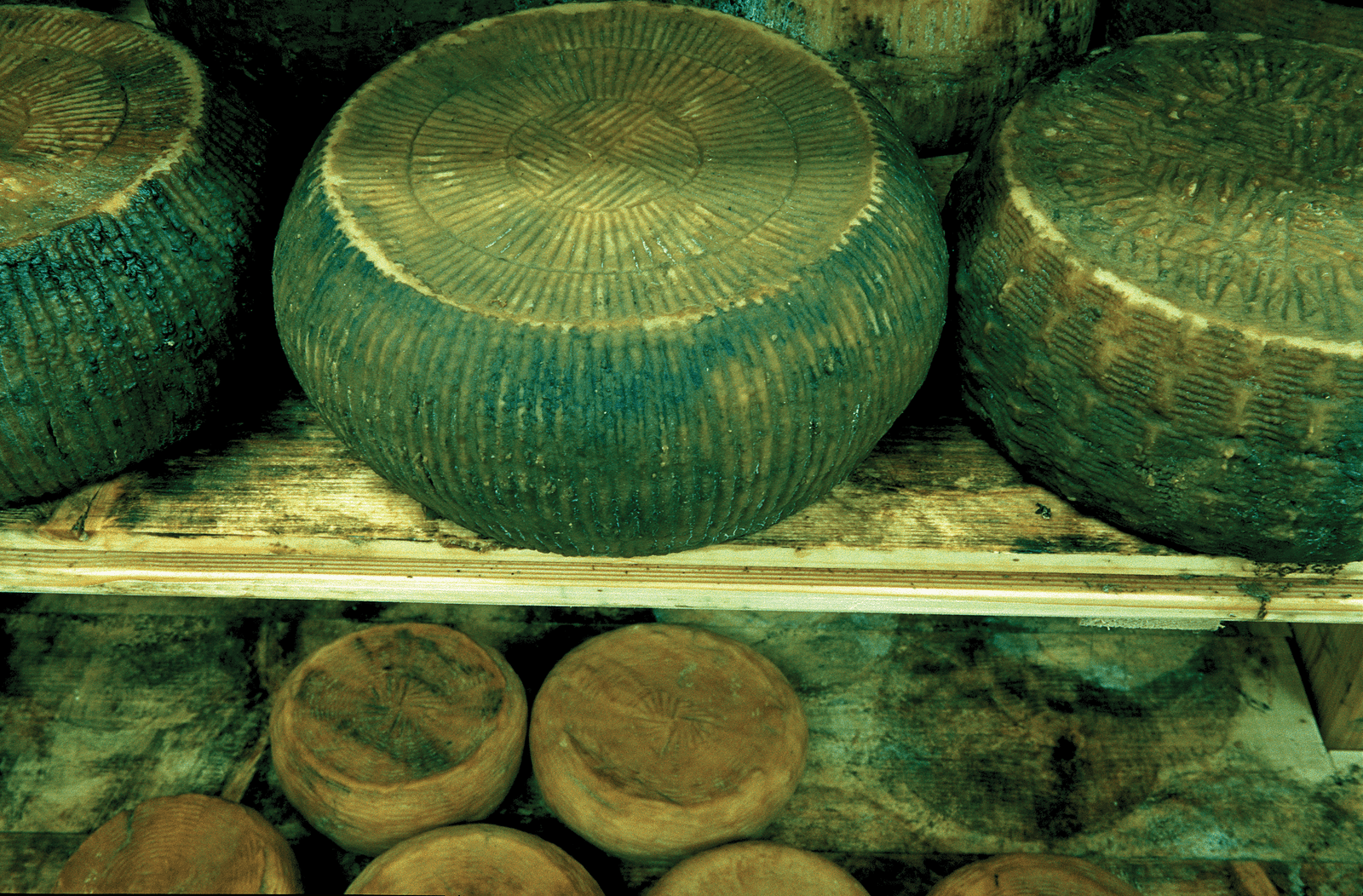
Photo credit: © Archivio Slow Food
The prized cheese from Italy’s Abruzzo region is made exclusively by women
I first encountered the unique sheep’s milk cheese Pecorino di Farindola while browsing at the Eataly cheese counter in Florence, Italy. I noticed a sign for a pecorino made with caglio suino (pig rennet), something I’d never seen or heard of. I asked the monger about it, and she pulled out a wheel so I could take a closer look. “It’s very distinctive,” she said. “But it’s not for the faint of heart!”
To say I was intrigued is an understatement. I bought a wedge and went straight home so I could taste it. It was quite strong, with a bitter flavor and a spicy finish. It reminded me slightly of Provolone Piccante, but even more intense with a drier, more crumbly texture. It was certainly unlike any other pecorino that I’d ever tasted! I had to find out more.
Ancient Origins
Although I initially came across the cheese in Tuscany, I learned that Pecorino di Farindola is made in a small area of Abruzzo, one of Italy’s greenest regions, with three national parks and the highest and most dramatic peaks of the Apennines. Specifically, this pecorino is produced on the eastern slopes of the rocky Gran Sasso d’Italia massif, and it takes its name from the town of Farindola, which was once heavily populated by shepherds because of its extensive, lush pastures.
“The history of this cheese in this area goes back over 2,000 years,” explains Fiorenzo Sarto, a partner in the cooperative Masserie del Parco, one of 13 small producers of Pecorino di Farindola today. He references “Vestini cheese” made with pig rennet in Roman times, when the Vestini tribe lived in the mountains of this region. “The characteristics have persisted through time, with few changes.”
Production dwindled in the 1990s, due to significant post-war emigration and a decrease in sheep farming. Pecorino di Farindola was named a Slow Food Presidium product in 2001, with the goal of safeguarding and reinvigorating production. It is generally believed to be the only cheese in Italy, and possibly the world, made with pig rennet.
“Pig rennet doesn’t exist [to buy]; we make it at home, from pigs we raise ourselves. It’s not industrial, it’s labor intensive—and rather complicated,” says Sarto, who also serves as the Slow Food Presidium Producers’ coordinator. There are variations from family to family…but only in this little area do we use rennet obtained from the stomach of a pig and the local white wine, Montonico, left to infuse for three to four months, or even over a year.”
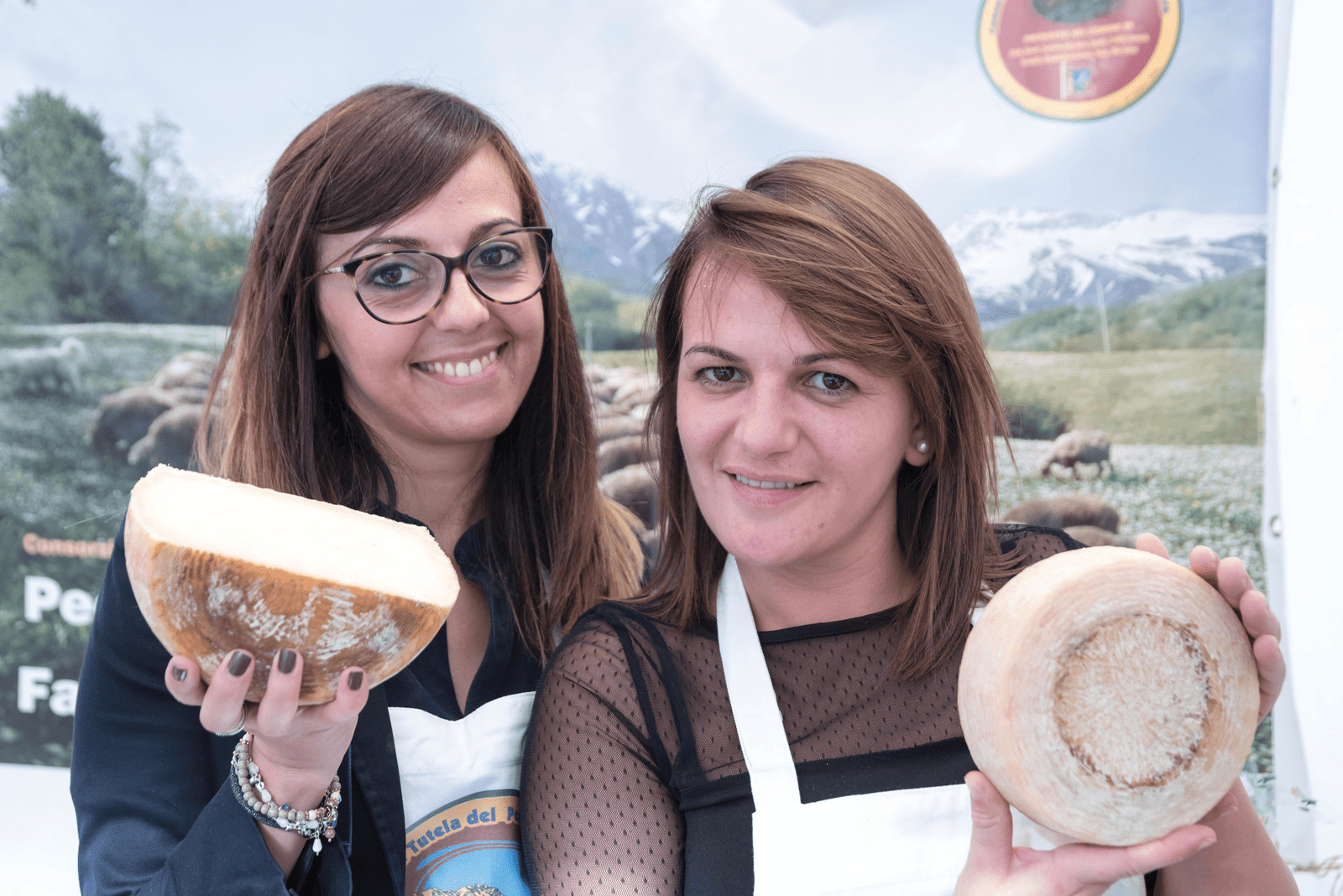
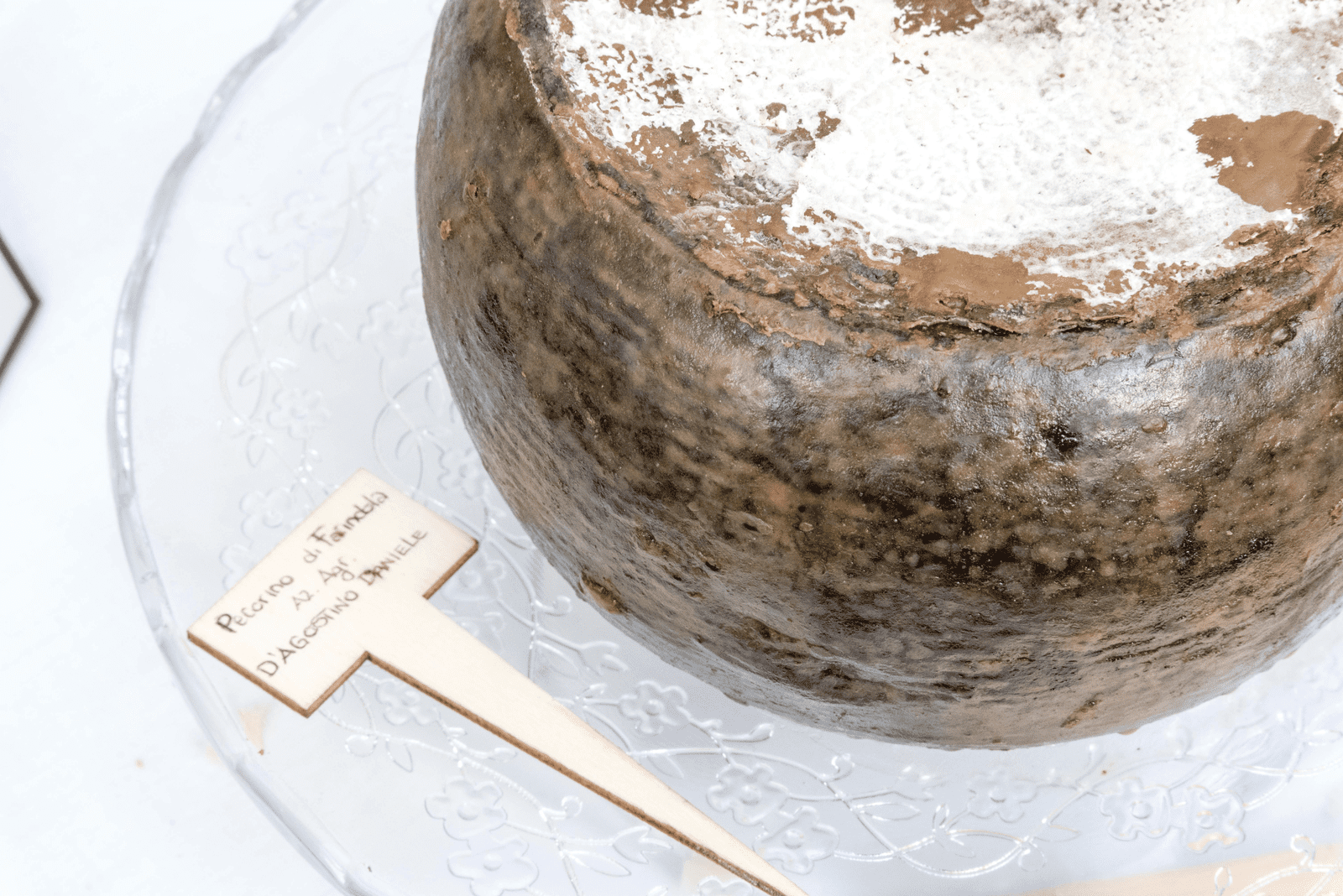
The Women’s Cheese
Another hallmark of Pecorino di Farindola is that it is made exclusively by women. Historically, the men tended to the grazing and care of the sheep, and the women handled the transformation of the milk into cheese and the aging process. The recipe and technique are passed down from generation to generation, so the cheese is also known as pecorino delle donne (women’s cheese).
“We wanted to preserve the transfer of this tradition from mother to daughter, which is tied to the culture of this small area. Just five kilometers away cheese is made in a different way. It’s beautiful to maintain this custom,” Sarto says.
In fact, on the label of every wheel of Pecorino di Farindola is the name of the woman who made it. At Masserie del Parco, Sarto’s partner Silvia currently produces the pecorino, who learned how to make the cheese from her mother, Sara.
A consortium of producers was formed in 2002 to help guarantee the continuation of traditional practices throughout the cheesemaking process. Only raw milk from sheep raised in the limited production area is used to make Pecorino di Farindola. After the pig rennet is added and the milk coagulates, the curd is cut into small pieces and placed into woven reed baskets, which give the rind its characteristic pattern. The cheese is left to drain for about a day, and then is dry salted by hand and aged on wooden shelves for a minimum of three months to over a year. The wheels are periodically rubbed with local extra virgin olive oil as they mature.
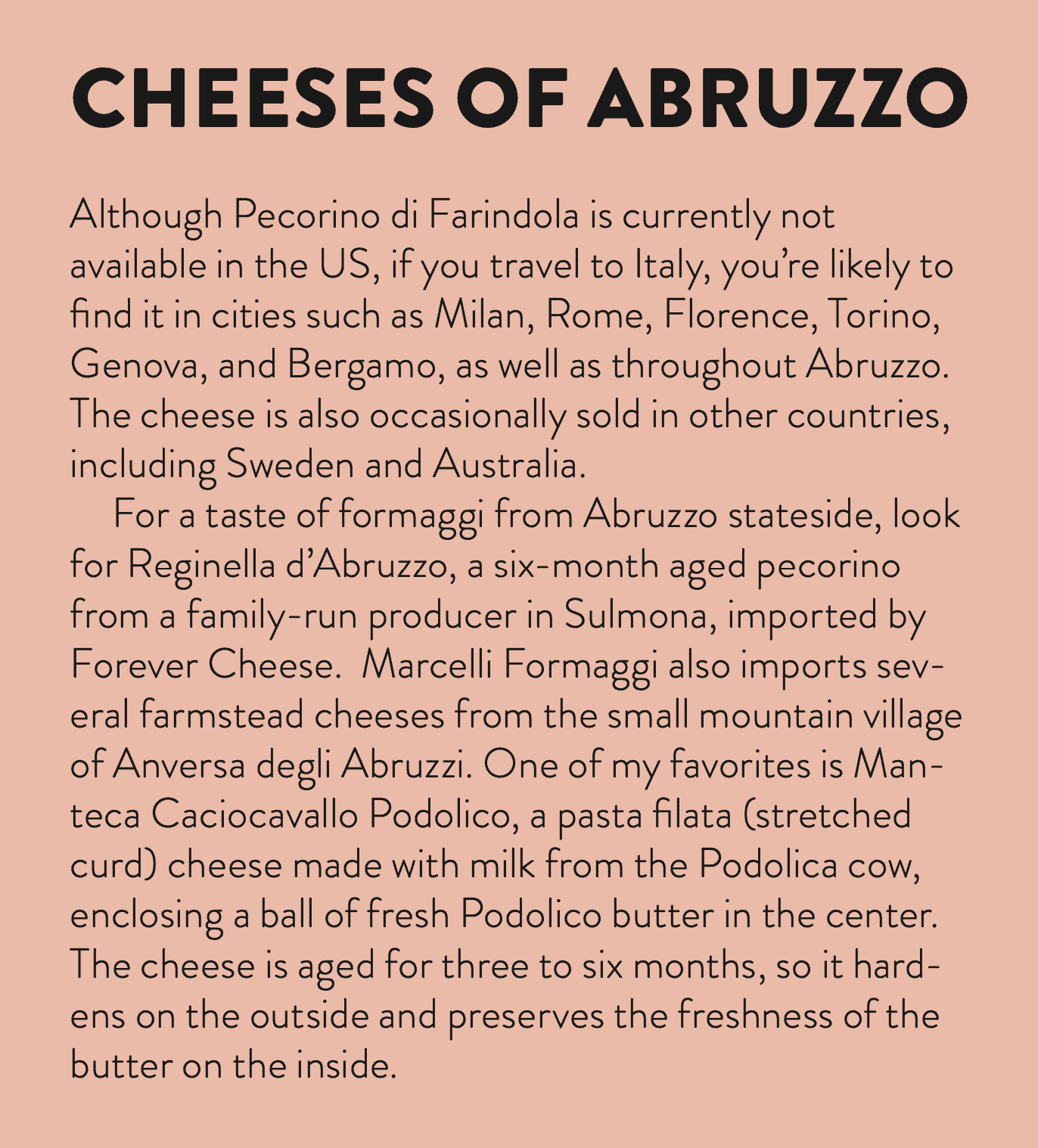
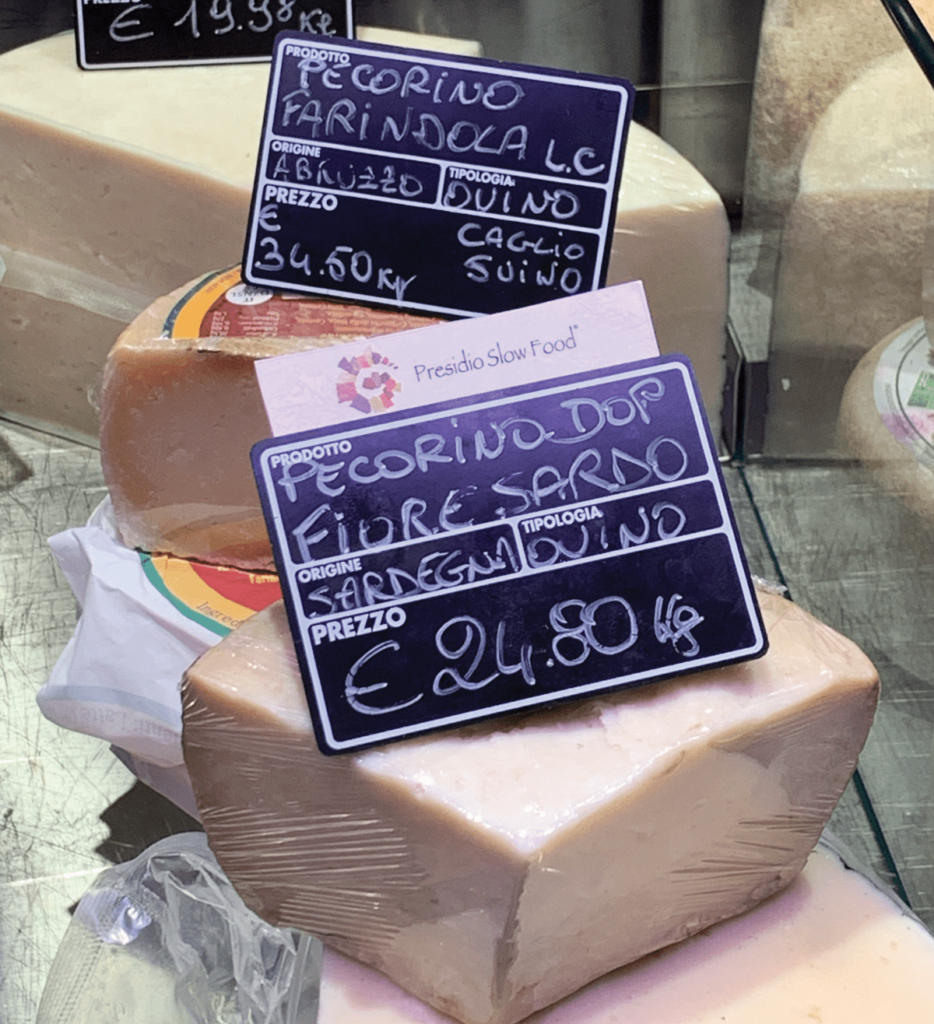
How to Enjoy
Pecorino di Farindola that has been aged four to five months (semistagionato) is traditionally eaten with bread, local olive oil, and occasionally fava beans. More recent pairings include fig jam, acacia honey, or mosto cotto, a syrup derived from cooked grapes that is another typical ingredient in Abruzzo. “Something sweet, but not too strong so the flavor of the cheese can prevail,” explains Sarto.
I tried a semistagionato wedge of Pecorino di Farindola when I was visiting friends in the quaint coastal town of Tortoreto in Abruzzo last summer. It was much milder and less spicy than the cheese I tasted in Florence, which had been aged for a longer period. More mature Pecorino di Farindola can be enjoyed on its own, as well as grated on pasta, and paired with full-bodied red wines such as Montepulciano d’Abruzzo and Cerasuolo d’Abruzzo.

The Peculiarity of Pig Rennet
My third experience with Pecorino di Farindola was at the Slow Food Cheese Festival in Bra, Piemonte, in September 2021. It was here that I briefly met Trevor Warmedahl (@milk_trekker on Instagram), a nomadic cheesemaker and dairy researcher, and the recipient of the 2022 Daphne Zepos Teaching Award. His project is focused on rennet and other coagulants, and how they’re produced and used.
Warmedahl tasted Pecorino di Farindola for the first time in Bra, and said the strong flavor reminded him of that of Casín from Asturias, Spain, and some Sicilian cheeses that typically have a piquant bite. “But I’ve only tasted this cheese once, and I’ve learned you need to give a cheese multiple tries,” he says. “Cheese is the ultimate food for expanding your palate.”
I recently reached out to Warmedahl to ask if he’d ever encountered another cheese made with pig rennet in his travels. He hadn’t. “But I have heard stories in countries like Georgia, where they say up in the hills when people don’t have rennet or they run out from animals, they use whatever animal stomachs [they can to coagulate milk]…rabbit is a common one that I’ve heard,” he says.
The question of why pig rennet came to be used to make this cheese thousands of years ago remains unanswered, according to Sarto. “I don’t know why they don’t do it in other places; it’s so good! We need to do a survey,” he says, laughing. “Probably in the past the populations were very jealous of their local agricultural traditions and wanted to preserve and protect their own, and so this cheese, made in this very particular way, was only ever made here.”
“It’s not a cheese that we make a lot of—the production is very small,” he adds. “But I’m happy that people are talking about Pecorino di Farindola, and I’m happy for this little territory. Whoever is interested, I’ll send it to them!”
If You Go
Abruzzo is located in central Italy, east of Rome, with a coastline on the Adriatic Sea and imposing mountains and lakes inland. The Gran Sasso e Monti della Laga National Park is one of the most biodiverse places in Europe. The region attracts skiers, hikers, mountain bikers, and other outdoor enthusiasts, and is also worth exploring for its food and wine. Be sure to try spaghetti alla chitarra (guitar spaghetti), which takes its name from the wooden tool with guitar-like strings that is traditionally used to hand-cut the dough. It’s typically served in a tomato sauce with pallottine (mini meatballs).




